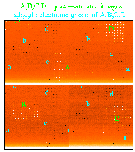|
|
NICS - Electronics
The array is controlled and read-out by the "FASTI-NICS" electronics system
developed by the Infrared Group of the INAF-Arcetri Observatory of Florence.
Described below are only the few aspects which could be of interest
for a normal observing run, more detailed information can be found in the
dedicated web site.
Noise performances and integration times (changed on February 2006)
|
| Observing mode |
Suggested DIT (sec) |
| Imaging J/Js/Y |
60 (LF) |
240 (SF) |
| Imaging H/K'/K/Ks |
25 (LF) |
100 (SF) |
| Ima narrow band |
150 (LF) |
600 (SF) |
| Spectroscopy Amici |
120 x (1"/slit-width) |
| Spectroscopy |
600-900* |
|
The read-out noise of the system is about 24 electrons or,
equivalently, 3 ADU counts on a single frame;
The conversion factor is close to 8 electrons/ADU.
To make sure that imaging observations are background limited
and to limit the annoying effects related to the
bias variations
it is convenient using detector on-chip integration times (DIT) long enough to obtain
a sky level of at least 1500 counts. However, be careful not to
exceed 15,000 ADUs to avoid non-linearity, note also that the
detector saturates at about 20,000 ADU counts.
For observations in conditions of low background, e.g. spectroscopy
or narrow band imaging, the detector integration time can be increased
up to about 15 minutes. Longer integrations are not recommended.
Short integration times should be used only to observe very
bright sources.
The minimum on-chip integration time is 3 seconds. If this is
not short enough one can use the
grey filters to
attenuate the signal by up to 10 magnitudes.
The table here summarizes the values of detector integration times
which should guarantee good performances for observations of faint
objects. Entries marked with a "*" indicate that the
maximum value of DIT is not sufficient to guarantee background-limited
performances, i.e. that the data taken with this observing mode will be most
likely read-out noise limited.
Please note that imaging with the small field camera (SF)
should require integration times
a factor of 4 longer than those with the large field camera (LF).
In spectroscopy, the data taken with low and medium resolution
grisms are read-out noise limited at all the wavelengths where the sky emission is low.
The only mode which achieves background limited
performances at most wavelengths is low-R spectroscopy with the Amici prism.
However, this requires a careful tuning of the value of DIT to obtain a reasonably high signal
in the blue without saturating the red part of the spectrum.
The value given in the table should guarantee good performances in the blue with saturation
starting at about 2.4 microns, click here to see a representative sky
spectrum taken with the Amici prism. Other examples of sky spectra taken with various grisms can be found in the
section dedicated to wavelength calibration and sky spectra.
|
Overheads (changed on February 2006)
|
|
Main overheads
|
|
Detector read-out (every DIT) |
2.5 sec |
|
Image transfer (every NDIT) |
7 sec |
|
Telescope offset |
15 sec |
|
The table here summarizes the main overheads which noticeably, are now much lower than before the refurbishing of the control electronics of Feb 2006. The total time spent for an integration with a given on-chip integration (DIT), an averaging NDIT imaging before writing them on disk, repeated in n positions (Npos), is given by:
Ttot=((DIT+2.5) * NDIT + 7 sec + 15 sec) * Npos
The time necessary for moving the telescope (15 sec) is virtually independent of the offset amplitude.
|
Cross talking (changed on September 2006)
|

Example of cross-talking
|
Due to a spurious coupling between the electronic
channels which simultaneously read the 4 sections of the array,
whatever signal detected in a given quadrant produces negative ghost images
in the other 3 quadrants.
Apart for the large improvement which occured
after the intrument refurbishing of Feb-Apr 2003, the cross-talking
is very stable and can be partially corrected by applying a
suitable algorithm in the pre-reduction phase.
To this purpose you can use one of the following Fortran programs which eliminate
most of the cross-talking effects produced by non-saturated images.
WARNING: the algorithm does not completely correct the
cross talking of saturated images but leaves
positive ghosts.
The program takes the original fits file of NICS
and produce another fits file preserving all the original headers
and keywords. Instructions for compiling and using the program are inserted
as first comment lines in the files. You may download here:
- The source file for data
taken after Sep 2006, this runs on PC systems.
- The source file for data
taken after Sep 2006, this runs on Sun, HP systems.
- The source file for data
taken between Feb 2006 and Sep 2006, this runs on PC systems.
- The source file for data
taken between Feb 2006 and Sep 2006, this runs on Sun, HP systems.
- The source file for data
taken between Mar 2003 and Jan 2006, this runs on PC systems.
- The source file for data
taken between Mar 2003 and Jan 2006, this runs on Sun, HP systems.
- The source file for data
taken before Feb 2003, this runs on PC systems.
- The source file for data
taken before Feb 2003, this runs on Sun, HP systems.
If you have different systems try using both, the wrong one
will produce quasi-random results.
|
For any comments please contact Vania Lorenzi.
|


